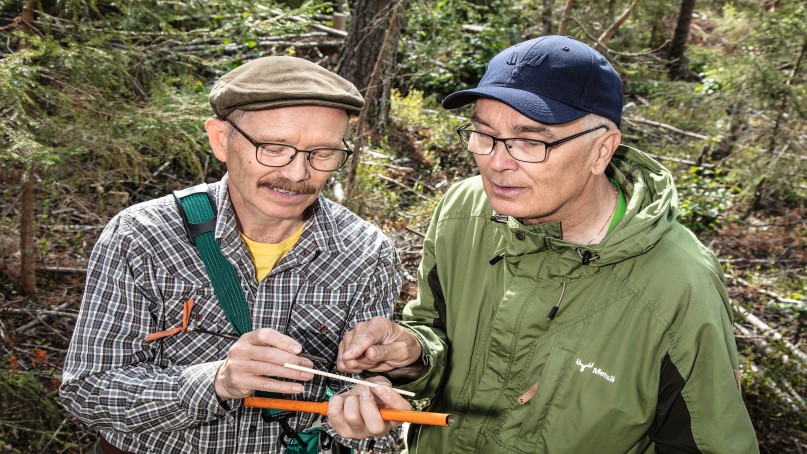Forest owner Matti Laitinen leaps skilfully across the forest ditch. The bottom of the ditch, dug out in this pine mire exactly 40 years ago, is covered by water after the weekend rains, but this doesn’t bother Laitinen. On the contrary, a satisfied Laitinen surveys the recent thinning site. “I feel good. It looks like the work’s been successful.”
Testing something new
The thinning site, which was harvested in the early spring, is special in many ways. Just a few years ago, the guidelines would have recommended cleaning the old ditches and channelling the water away from the area where it was stifling growth. The ditches were now left untouched. Instead of cleaning the ditches, ash from Metsä Group’s own power plants was applied in the forest.
This approach is based on new research conducted in recent years. According to the research results, ash fertilisation boosts the growth of trees left standing and leads to trees transpiring at an increasing rate. As accelerating growth means more water transpired, there is no need to clean the ditches.
Although Laitinen first doubted the new operating model, he and Markku Knuutinen from Metsä Group concluded that the site could be managed differently. The nutrient richness of the soil and the volume and quality of the growing stock reinforced this view.
“Ash fertilisation enables the nutrient content to be balanced, and the nitrogen bound in the soil to be used for tree growth. It’s almost certain this will work,” says Knuutinen.

A win-win situation
Six months after the felling and fertilisation, Laitinen no longer yearns for drainage. This way, more was achieved with lower costs. According to Laitinen and Knuutinen, the new method benefits everyone. The solution was the best option in view of the growth rate, financial income from forestry, impact on waterbodies and carbon storage.
“Peat stores eight times more carbon than the trees in the forest. If the water level in peatlands falls too low, the carbon in the peat is released into the atmosphere. This is not what we want: by avoiding drainage, we can store carbon in the soil,” says Knuutinen.
Ash doesn’t work magic everywhere
Markku Utriainen, forestry operator, shovels up a peat sample from a depth of 40 centimetres. The black peat is full of vitality. “This is well decomposed. The plant remains have decomposed nearly fully, and the peat contains a lot of nitrogen that accelerates tree growth.”
Utriainen expects ash fertilisation to boost tree growth by several cubic metres per hectare annually. “The impact of ditch cleaning would be much smaller. Fertilisation also has a longer-lasting impact on growth than drainage repair,” he says.
However, Utriainen does not recommend ash fertilisation for thinning in all peatland forests. “The drainage must be in moderately good shape. The ditches do not need to be in perfect condition, but nor must the site be flooded by water. In addition, you need roughly one hundred cubic metres of wood to ensure that water evaporates and enough nitrogen in the peat to secure good conditions for tree growth. Fertilisation is not useful in a barren bog.”
A new generation of trees is growing
Prior to thinning, the area was pre-cleared to facilitate machine work. Instead of total clearing, the work was concentrated near the trunks to be removed and birch trees were deliberately spared because they are very efficient water evaporators.
In addition to the birch trees, the felling area is characterised by understory spruces growing under the pine trees and small pine catkins that emerged this summer. The complexity of the stand prompted to consider a switch to continuous canopy cover. "We strive to use natural seedlings whenever possible," says Laitinen.
According to Markku Knuutinen, the conditions for continuous cover forestry are often best in peatland forests. Continuous cover forestry methods produce good results when the site is suitable.
"Conditions, forest management practices and the forest owner's objectives must be matched on a case-by-case basis. In the management of peatland forests in particular, we are moving towards more precise and site-specific planning, resulting in both good growth effects and reduced environmental impacts."
This article was published in issue 3/2022 of Metsä Group’s Viesti magazine.
Text Heikki Hamunen
Photos Harri Mäenpää
